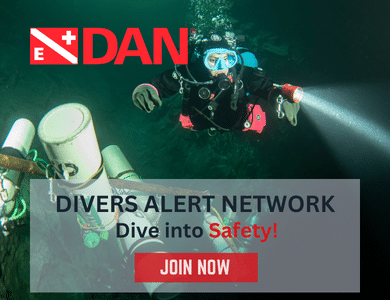Thursday, 16 May 2024
Menu

I have been in Poole every year for the past 8 years for diving historians conferences and it has been easier for me to persuade the RNLI lifeguards to come to Poland at their HQ which is in Poole. There is also a small museum recalling the history of water rescue.
The RNLI – Royal National Lifeboat Institution – is an English social rescue organisation, one of the best in the world, which was founded in 1824. In 1866, the Polish magazine “Wędrowiec” published an article about the activities of this English association for rescuing the drowning, which in its work used boats commonly called Lifeboats.
[blockquote style=”2″]”Lifeboat” – we read in the Wanderer – is a non-sinking boat, 10 m long, 2.5 m wide, arranged for ten rowers with a rudder. It had the advantage of always remaining afloat, as it was provided with two large air tanks.”[/blockquote]
“Lifeboat” has remained in the RNLI name and usage to this day, albeit heavily modernised.
After two intensive days of training, the last lecture on the command of rescue operations on water, seems to me so universal, that perhaps it is worth bringing its main theses to our diving community. Anyway, the workshop was attended by 78 participants from all over Poland, divers were quite well represented, including representatives of the CMAS Underwater Activities Committee.
The RNLI alone launched lifeboats to assist divers on as many as 81 occasions last year, and 50 divers died in English waters between 2011 and 2015. That’s why the RNLI has launched “Sea survival for divers” training (How to survive at sea, for divers), stressing how important it is for divers’ safety to have a Personal Locator Beacon (PLB).( The only problem is that the PLB has to be sealed in a sealed diving container. The rest is the same procedure as for the EPRB buoy known from sailing).
The training programme for lifeguards presented to us by the English usually takes a week at home. With us, they tried to convey everything at least in outline within less than 2 days. They also promised further cooperation and made their training materials available.
On the second day of the workshop with practical classes on water, about 30 participants stayed in Gdynia. For them there was also one of the most important, in my opinion, lectures of the whole workshop.
The lecture was on rescue management, and although examples were shown of water rescues, the message was universal, for all kinds of rescue operations. Amazingly simple in its logic and often surprising. The greatest conformity with the presented English way of thinking could be seen in the groups of rescuers from the Water Rescue Squads of the Volunteer Fire Brigades, which is certainly due to the unified training system in TSOs.
At the beginning of the lecture the question was asked – What happens when an accident is reported requiring immediate intervention of rescuers, and it is you who has to lead the rescue team?
It appears that you are expected to be able to answer, above all to yourself, in a minute or 2, a number of relevant questions covering such issues:
What do I need to lead the action effectively?
– Support group
– Action plan and guidelines
– Communication methods
– Command structure adopted
– Administrative support
– Appropriate means
Here it is worth emphasising that under the heading “Adopted Command Structure” is nothing other than a designated, unquestionable and competent leader of the action, who has the authority and manages the means to carry out the rescue operation as quickly and safely as possible, also for the rescuers. The requirement to identify such a manager/commander in the UK is a result of legislation.
With a leadership role comes, of course, a great deal of responsibility, for gathering information, identifying hazards, implementing a safe system of action, accessing resources, formulating a plan with priorities, taking account of environmental conditions, agreeing on a communication system, liaising with other rescue groups, the welfare of rescuers, reporting to other rescuers, establishing facilities and keeping the risk assessment up to date with updated action plans. Undoubtedly, this is a lot.
If you are well trained, and have been appointed as an action manager, you almost automatically have.
[pro_ad_display_adzone id=”31298″]










Welcome to DIVERS24.COM, your daily source of scuba news, freediving, scuba diving information, and equipment reviews. Our comprehensive coverage of the dive industry from A to Z provides you with all the latest scuba news, training updates, underwater photography tips, and everything else related to scuba diving. Whether you’re a beginner or an experienced diver looking for more knowledge about scuba gear or techniques – we’ve got it covered! With our in-depth articles written by experienced divers who have been there and done that, you are sure to find exactly what you need here at Divers24.com. Dive into scuba news today!
Underwater Media Sp. z o.o.
Szafarnia 11/F8,
80-755 Gdansk, Poland
Welcome to DIVERS24.COM, your daily source of scuba news, freediving, and scuba diving information. Sign in for a weekly news update and discount coupons for dive gear and apparel.
@2023 - underwatermedia.pl. All Right Reserved. Designed and Developed by Tworzenie stron internetowych Gdansk

The Divers24 portal is currently the largest online medium treating diving in Poland. Since 2010 we have been providing interesting and important information from Poland and around the world on all forms of diving and related activities.
Contact us: info@divers24.com